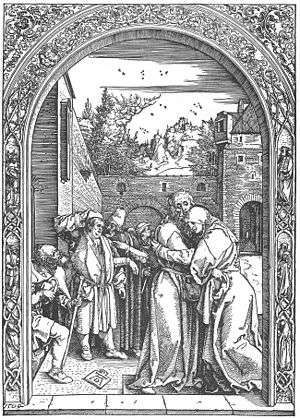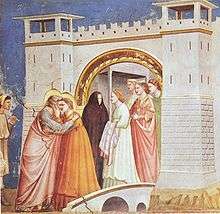Joachim and Anne Meeting at the Golden Gate

Joachim and Anne Meeting at the Golden Gate is a 1504 woodcut by the German artist Albrecht Dürer that depicts the standard scene of the parents of the Virgin Mary, Joachim and Anne meeting at the Golden Gate of Jerusalem, upon learning that she will bear a child.
Legend
The story is not in the New Testament, but is in the Protoevangelium of James and other apocryphal accounts; however it was tolerated by the Church. The print shows an embracing couple beneath an ornamental archway, surrounded by neighbours and fools.
The work is one of 16 woodcuts and prints in Dürer's Life of the Virgin series, which he executed between 1501 and 1511. Joachim and Anne Meeting at the Golden Gate is the only work in the series to include a date.[1] Throughout the series, the Virgin is displayed as an intermediary between the divine and the earth, yet shown with a range of human frailties. The full series of prints was first published in 1511. Printed on the reverse of each was a Latin text written by a member of his intellectual circle in Nuremberg, the Benedictine Abbot Benedictus Chelidonius.[2]
The work describes the story of the married couple Joachim and Anne, who, though they were devoted to each other, were deeply unhappy as they were childless, which they took as a sign that they must have been rejected by God. An angel informs Anne of her conception, while at the same time asking her to meet her husband at the city gate in Jerusalem. On meeting, the couple entwine in joy. According to Chelidonius: "Overjoyed Anne threw herself into the arms of her husband; together they rejoiced about the honour that was to be granted them in the form of a child. For they knew from the heavenly messenger that the child would be a Queen, powerful on heaven and on earth".[3] In traditional depictions of the occasion, the pair embrace, but don't kiss.[4]

Dürer here follows an early Renaissance convention involving the illusion of looking through an open window. He framed many of his works in this way, including Joachim and Anne Meeting at the Golden Gate, which is outlined by a Renaissance arch.[5] The artist's mix of classical and sixteenth-century Nuremberg motifs, as well as the northern European setting, were utilised to bring the images closer to the audience. According to the critic Laurie Meunier Graves, "these prints manage to illuminate the sacred while at the same time providing scenes of homely, Renaissance life. They are a beautiful blend of the holy and the secular. In addition, woodcuts are an art form that gives plenty of latitude to the imagination and leaves room for fancy."[6] As with the other works in the series, it is distinguished by virtuoso use of line and highly skilled cutting.[7]
Notes
- ↑ Willi (1935), p. 25.
- ↑ "Albrecht Durer (Nuremberg, 1471–1528): The Engraved Passion". Spaightwood Galleries. Retrieved on 18 October 2007.
- ↑ Nurnberg (1983), Ilus. 59.
- ↑ Lubbock, Tom. "The Meeting at the Golden Gate (1305)". The Independent (UK), 16 February 2007. Retrieved on 14 October 2007.
- ↑ Shaw-Eagle, Joanna. "Four Exhibits Drawn Together". The Washington Times, 29 July 2000.
- ↑ Meunier Graves, Laurie. "Dürer's life of the Virgin as social document". Retrieved on 18 October 2007.
- ↑ "The Life of the Virgin". "German 16th Century Prints". Victoria: Art Gallery of Greater Victoria, 1983. Retrieved on 18 October 2007.
Sources
- Kurth, Dr. Willi. "The complete woodcuts of Albrecht Durer". New York: Arden Book Co, 1935.
- Nurnberg, Verlag Hans Carl. "Dürer in Dublin: Engravings and woodcuts of Albrecht Dürer". Chester Beatty Libraery, 1983.
- Strauss, Walter L. "Albrecht Durer Woodcuts and Woodblocks". The Burlington Magazine, Vol. 124, No. 955, October, 1982. pp. 638–639.
External links
| Wikimedia Commons has media related to Albrecht Dürer woodcut series – Life of the Virgin. |
